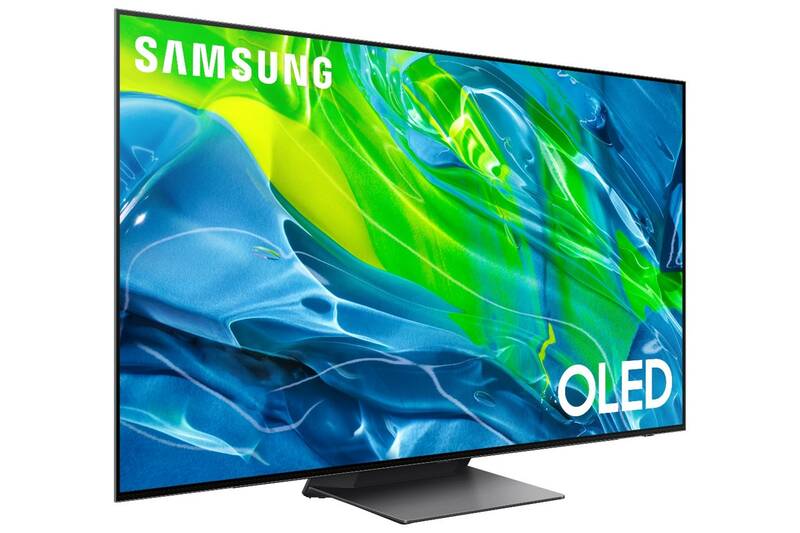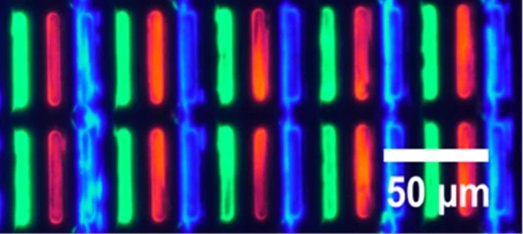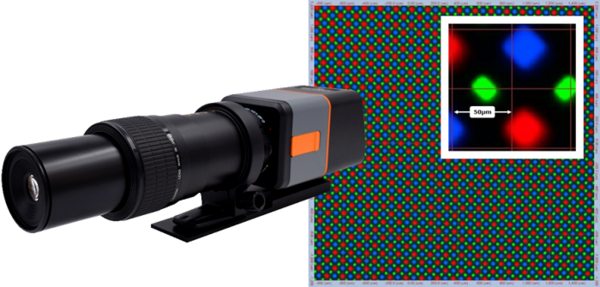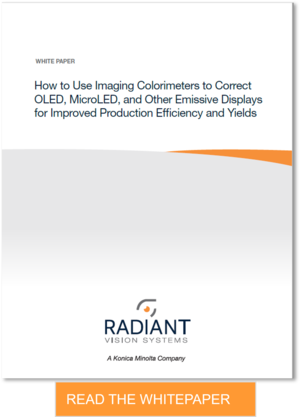Quantum Leap: Quantum-Dot LED (QLED) and OLED (QD-OLED) TVs Have Arrived
Quantum dot layers have been used as a color filter with LCD display screens for a few years now. Light from a blue LED backlight shines through this quantum dot enhancement layers (QDEF), converting some of the blue light to red and green to provide a wide gamut of colors. First commercialized by Sony in 2013, the display approach was labeled QLED. It was adopted by display makers including Samsung, LG, Sharp, and CSOT. By 2020, these four brands held a combined 70%1 share of the QLED market.
Quantum Dot Display Technologies
Quantum dots are tiny nanocrystals. When struck by a high-energy light photon, they absorb it and emit a new photon. The emitted photon can be different colors, depending on the size of the nanocrystal. This simplifies the manufacture of quantum dots compared to LEDs. Each color of LED crystal requires a different chemical composition. But quantum dot makers can use the same material for every color, simply by varying the size.

Relative sizes of different colored quantum dots, (Image source: Samsung)
One drawback of the QLED technology, however, is that a QD filter layer (like any filter) works by blocking certain colors of light. This can reduce overall display brightness by as much as two thirds.2 A different approach uses quantum dots as a color converter (QDCC) layer. QDCC technology uses quantum dots not as filter, but as a conversion layer, enhancing brightness and color purity while increasing power efficiency. Samsung touts the viewing angle performance and high contrast ratio of its quantum dot displays, and even says its latest screens “optimize” blue light exposure that can be harmful to the human eye and sleep patterns.3

Comparing quantum dot filter layer display structure (left) where two-thirds of light is blocked at the filter level, versus the QD-OLED conversion layer method, which produces brighter images because 100% of light is passed through the conversion layer. (Image: © Nanosys)
QD-OLED Displays Reach the Market
QDCCs can be used with either microLED or OLED display panels to provide a wide color gamut and exciting viewing experience. But until now, displays using QDCCs were not readily available to the mass market. Then Samsung showed its first commercial QDCC displays—called QD-OLED—at CES 2022. The market has been eagerly awaiting the release of its new S95B QD-OLED model, which has just become available for order this month in 55" and 65" sizes.

Samsung’s new QD-OLED television, the S95B. (Image © Samsung)
Sony is also planning to release a QD-OLED model later in 2022. For consumers wanting a peak viewing experience, QD-OLED could be the answer. These displays “show better color volume, covering 90% of Rec.2020 color gamut with peak brightness of 1500 nits, while current OLED and LCD TVs cover only 70-75% of Rec.2020.”4
Increasing adoption of QLED in the high-end television market combined with excitement about the newest QD-OLED models is driving up the overall demand for quantum dot displays. The market is projected to grow rapidly in 2022 and beyond, with a projected CAGR of 29.2% through 2026.5

A high-resolution, full-color quantum dot (QLED) display fabricated vie photolighography. (Image Source6)
Quantum-Dot Display Quality and Performance
While they may offer superior visual performance, quantum-dot displays are still subject to the same quality issues as traditional displays. Regardless of whether the technology is LED, OLED, QLED or QD-LED, visual defects and mura (blemishes) can affect uniformity. These imperfections will mar the viewing experience and create customer dissatisfaction if they’re not identified and corrected during production. Radiant’s visual inspection solutions measure display performance and uniformity down to the pixel and subpixel level—with precise spatial resolution as fine as 0.45 µm.
We have developed a proprietary method for measuring and correcting pixel-to-pixel variation in OLED, microLED, and other advanced display technologies. Our ProMetric® Imaging Photometers and Colorimeters match the acuity and discernment of human visual perception of light and color to ensure the absolute quality of today’s ultra-high-resolution screens. When used alone or with our Microscope Lens, Radiant solutions enable QD display manufacturers to asses visual performance—at production line speeds, with subpixel accuracy, and with repeatable results.

A Radiant ProMetric Y Imaging Photometer with Microscope Lens, applied to measure subpixels of an OLED display.
Learn more about inspection methods for emissive displays such as OLED, microLED, and quantum dot in the white paper, “How to use Imaging Colorimeters to Correct OLED, MicroLED and Other Emissive Displays for Improved Production Efficiency and Yields.”

CITATIONS
- Global Quantum Dot Display (QLED) Market Research Report 2020. 360 ResearchReports, January 1, 2022.
- Chen, H., He, J., and Wu, S. Recent advances on quantum-dot-enhanced liquid crystal displays. IEEE Journal of Selected Topics in Quantum Electronics Vol. 23, No. 5 (2017). DOI 10.1109/JSTQE.2017.2649466
- Quantum Dot, https://www.samsungdisplay.com/eng/tech/quantum-dot.jsp (Retrieved April 15, 2022).
- Porter, J., “Samsung Display’s new QD-OLED panel can hit 1,000 nits brightness for improved HDR." The Verge, January 10, 2022.
- Global Quantum Dot Display (QLED) Market Research Report 2020. 360 ResearchReports, January 1, 2022.
- Mei, W., Zhang, Z., Zhang, A. et al. "High-resolution, full-color quantum dot light-emitting diode display fabricated via photolithography approach." Nano Research 13, pp 2485–2491, June 25, 2020. DOI: 10.1007/s12274-020-2883-9
Join Mailing List
Stay up to date on our latest products, blog content, and events.
Join our Mailing List
